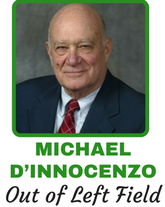A major historian contends that the President voters elect is “the nation everyone gets, and, indeed, it is the world that everyone gets.”
While I was traveling abroad in 2008, I read a strong reinforcement of that view in the French paper, “Le Monde.”
The editor argued that everyone in the world should have a vote for the American President because the entire globe would be affected by that selection.
As I mentioned in my previous column, formal ratings of Presidents have been occurring since 1948.
In my earlier essay, I was only able to consider why half a dozen Presidents were considered the worst in our history.
Now, I turn here, primarily, to a consideration of the assessment process. [I will do another essay examining more extensively the factors that contribute to “greatness.”]
Past ratings have been criticized for having a northeastern, “liberal,” bias.
Because of that view, a book with the title “Rating the Presidents: A Ranking of U.S. Leaders, From The Great, And Honorable, To The Dishonest And Incompetent,” was published in 1997.
The authors, William Ridings and Scott McIver, made a careful effort to represent historians and political scientists from every region of the nation by engaging 719 scholars, and by including women historians (notably absent from earlier ratings – and, indeed, from the profession).
I was privileged to be one of the scholars invited to participate in the 1997 project.
I still like best the ratings by our group among the later ones.
Like some of the other polls, we affirmed the “Rushmore Four” by placing TR in our top 5 (he had been lower in earlier ratings). And we added FDR; he was No. 2 on our list, ahead of Washington.
The most recent ratings update was done in conjunction with 2017 President’s Day.
You can google that C-Span “Presidential Historians’ Survey, 2017” to see how the ratings have varied over three major assessments: 2000, 2009, to a few weeks ago.
Ninety-one impressive scholars participated in this C-Span endeavor; some were involved in all three of them.
A leader of the group is my former Hofstra colleague, Douglas Brinkley, presidential historian at Rice University.
When Doug is the featured speaker at Great Neck’s Temple Emanuel (3 p.m., Sunday April 30), I intend to ask him about some of the differences of the ratings by his group from mine.
Both of our groups placed Lincoln first.
Indeed, he has been first in every poll I can recall (except where Washington was No. 1 for the conservative Rasmussen poll, one by law school professors, and, if my memory is correct, one by the Wall Street Journal,).
My group placed FDR second, as did Doug’s C-Span in 2000.
But in the subsequent 2009 and 2017, FDR was dropped to third and Washington lifted to second.
So far, quite a bit of consistency — a slight variation where my group had TR at 5th, and
C-Span placed him 4th. Some other groups (Siena) have moved TR as high as 3rd.
Now, I can point to a major difference, as well as perspectives that have been added because we are two decades removed from 1997.
My group placed Jefferson 4th, but the C-Span group had him frozen at number 7 in all three of its polls.
Henry Steele Commager, the renowned Columbia professor for decades, would strongly disagree.
My dissent is not only because of the lowering of Jefferson, but also because of the Presidents that were placed ahead of him.
How do you feel about the 2017 C-Span judgment of placing Eisenhower 5th and Truman 6th?
And, what do you think about JFK in the 8th spot, only slightly behind Jefferson?
While C-Span has a bigger “points” gap to reach Reagan in 9th place, and Lyndon Johnson in 10th; do they deserve to be that high.
Since Barack Obama has concluded his eight year term, he was included in the 2017 ratings and reached the 12th slot, behind Wilson and ahead of Monroe.
C-Span used 10 categories for ratings whereas my group used five.
We shared the following categories, with slightly different names (C-Span’s listed 2nd):
“Political Skill” and “Public Persuasion”
“Character/Integrity” and Moral Authority”
“Accomplishments, Crisis Management” and “Crisis leadership”
“Appointments” and “Administrative Skills”
“Leadership Qualities” and two for C-span: “Relations with Congress”
And “Vision/Setting An Agenda”
C-Span also added four other significant ways to evaluate presidents:
“International Relations”
“Economic Management”
“Performance Within the Context of the Times”
“Pursued Equal Justice for All”
You might consider forming your own “Café Society” to apply these and other gauges to your ratings of our Presidents.
Then you can join us at Temple Emanuel on April 30 to hear the views of Douglas Brinkley, one of our nation’s most acclaimed presidential historians and public scholars.



